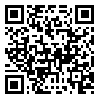Volume 9, Issue 2 (Autumn & Winter 2023)
KJES 2023, 9(2): 163-196 |
Back to browse issues page
Research code: 7912
Download citation:
BibTeX | RIS | EndNote | Medlars | ProCite | Reference Manager | RefWorks
Send citation to:



BibTeX | RIS | EndNote | Medlars | ProCite | Reference Manager | RefWorks
Send citation to:
keshtgar S, Heyhat M R, Bagheri S, Gholami E, Raiisosadat S N. Tectonic analysis of curved northern border of the Sistan zone with the Lut Block, north of Birjand. KJES 2023; 9 (2) :163-196
URL: http://gnf.khu.ac.ir/article-1-2873-en.html
URL: http://gnf.khu.ac.ir/article-1-2873-en.html
Shahriar Keshtgar *1 
 , Mahmoud Reza Heyhat2
, Mahmoud Reza Heyhat2 
 , Sasan Bagheri2
, Sasan Bagheri2 
 , Ebrahim Gholami2
, Ebrahim Gholami2 
 , Seyed Naser Raiisosadat2
, Seyed Naser Raiisosadat2 


 , Mahmoud Reza Heyhat2
, Mahmoud Reza Heyhat2 
 , Sasan Bagheri2
, Sasan Bagheri2 
 , Ebrahim Gholami2
, Ebrahim Gholami2 
 , Seyed Naser Raiisosadat2
, Seyed Naser Raiisosadat2 

1- University of Birjand , shahriar.keshtgar@gmail.com
2- University of Birjand
2- University of Birjand
Abstract: (1604 Views)
The curved fold-thrust belt of North Birjand contains some outcrops of Upper Paleozoic to Cenozoic sequences that have undergone several stages of deformation. Thrusting, large-scale parallel and radial folds, penetrative shear cleavage, tectonic klippes, tensile fractures, and conjugate strike-slip faults are exposed in this structural arc. The Chah-hoz region consists of Upper Cretaceous mélanges and listvenites with NW-trending thrust sheets dipping to the NE. The Mousavieh area includes pre-Cretaceous metamorphic rocks belonging to the basement of the Lut block, Cretaceous ophiolite, and turbidite complex, and Eocene platform limestone. The dip of thrust planes in the outer part of this arc is SSE and in the inner part of the arc is generally NNW indicating the direction of regional tectonic transport towards the interior of the arc. The abrupt boundary between the Eocene-Oligocene continental deposits in the north of this arc is either thrust or characterized by two types of major folds: The first type is the parallel folds with the edge of the arc, which are often cylindrical, but under the influence of the younger generation folds, they have become non-cylindrical, and the second type is the conical folds with a radial arrangement, the apex of the cone is plunged towards the NNW.
Therefore, it seems that the structures of the northern curved border of the Lut and Sistan terrains do not follow the model of common structures in linear collision mountains i.e., eastern Iran continental crust rifting and subsequent linear collision of the Lut and Afghan blocks. According to this research, it seems that the NW movement of the North Birjand platform was caused by buckling in the Late Eocene-Oligocene.
Therefore, it seems that the structures of the northern curved border of the Lut and Sistan terrains do not follow the model of common structures in linear collision mountains i.e., eastern Iran continental crust rifting and subsequent linear collision of the Lut and Afghan blocks. According to this research, it seems that the NW movement of the North Birjand platform was caused by buckling in the Late Eocene-Oligocene.
Type of Study: Original Research |
Subject:
Tectonics
Received: 2023/12/25 | Accepted: 2024/02/19 | Published: 2024/02/29
Received: 2023/12/25 | Accepted: 2024/02/19 | Published: 2024/02/29
Send email to the article author
| Rights and permissions | |
 |
This work is licensed under a Creative Commons Attribution-NonCommercial 4.0 International License. |




